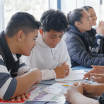Take a people-first approach
Consider how your knowledge of learners influences your approach to assessment design.
On this page:
On this page:
Current page section: Take a people-first approach
Go to top of current page: Take a people-first approach
Go to top of current page: Take a people-first approach
Go to top of current page: Take a people-first approach
Walk in my shoes
Walk in my shoes
Before you begin the design process, consider the three principles of UDL reframed from an ākonga perspective.
Engagement: Is the learning in this assessment of value to me, is it worth investing in and will I be supported to manage myself and succeed?
Representation: Can I see my cultures, identities, languages and communication modes, and the ways I make sense of information represented in this assessment?
Action and expression: Can I participate in this assessment and have equity of access to the tools and activities? Will I be able to express myself and demonstrate my understanding in ways that work for me? Will I be supported to plan and manage my learning?
Use a design process that begins with the people
Use a design process that begins with the people
Use this interactive version of the UDL Thinking Cycle to guide your people-first thinking.
Let your knowledge of ākonga influence how you design assessments and supports.
![12045 [UDL-thinking-cycle.png]](https://inclusive-live-storagestack-assetstorages3bucket-3uty0hejzw6u.s3.ap-southeast-2.amazonaws.com/public/example-images/UDL-thinking-cycle__ScaleMaxWidthWzEwODZd.png)
Source: Ministry of Education | Te Tāhuhu o te Mātauranga
Get to know me checklist
Get to know me checklist
Ākonga experience being seen when “who they are and what they bring”, influences the design of the learning.
In your subject area, consider how you create opportunities to learn about the following:
- cultures, languages and identities
- local connections and affiliations
- wairua, moral, wellbeing and physical health
- personal connections and relationships
- passions and challenges in different learning areas
- out of school and kura projects and activities
- dreams and aspirations
- learning preferences
- abilities and interests
- what might be “on top” for learners, e.g. a big performance, sports event, exams.
Ask what helps and build it in
Ask what helps and build it in
Ways to deepen understanding
Ways to deepen understanding
Examples of intentional ways to get to know students.
- Regular check-ins
- Discussion with whānau
- Noticing when students “light up” as learners because they are talking about or working on something they value
- Interviews and intentional conversations
- Creating opportunities for leadership.
- Opportunities to give feedback on teaching
- Short surveys
- Co-design opportunities where students and teachers design learning together
- Invite students to share insights or ask questions about real-world events
- Offer assignments and assessments that allow students to share their experiences and interests
- Attend extracurricular activities featuring your students
- Attend an event in your students’ community
Next steps
More suggestions for implementing the strategy “Design considerations in NCEA assessments”:
-
Current page Take a people-first approach
Return to the guide “Universal Design for Learning”

How to use this site
Guide to Index of the guide: Universal Design for Learning
Understand:
- Why UDL is valuable
-
Find out about UDLShow suggestions for Find out about UDL
Strategies for action:
-
Design multiple means of EngagementShow suggestions for Design multiple means of Engagement
-
Design multiple means of RepresentationShow suggestions for Design multiple means of Representation
-
Design multiple means of Action and ExpressionShow suggestions for Design multiple means of Action and Expression
-
How to plan using UDLShow suggestions for How to plan using UDL
-
Design considerations in primary settingsShow suggestions for Design considerations in primary settings
-
Design considerations in secondary settingsShow suggestions for Design considerations in secondary settings
-
Design considerations in NCEA assessmentsShow suggestions for Design considerations in NCEA assessments
- Take a people-first approach
- Design with students
- Identify barriers and supports
- Promote equity of access to supports
- Prepare for externally assessed standards
